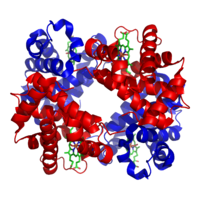
Photo from wikipedia
A single-molecule imaging approach detects individual disease-specific protein molecules in blood samples. The ability to characterize individual biomarker protein molecules in patient blood samples could enable diagnosis of diseases at… Click to show full abstract
A single-molecule imaging approach detects individual disease-specific protein molecules in blood samples. The ability to characterize individual biomarker protein molecules in patient blood samples could enable diagnosis of diseases at an earlier stage, when treatment is typically more effective. Single-molecule imaging offers a promising approach to accomplish this goal. However, thus far, single-molecule imaging methods have not been translated into the clinical setting. The detection limit of these methods has been confined to the picomolar (10−12 M) range, several orders of magnitude higher than the circulating concentrations of biomarker proteins present in many diseases. Here, we describe single-molecule augmented capture (SMAC), a single-molecule imaging technique to quantify and characterize individual protein molecules of interest down to the subfemtomolar (<10−15 M) range. We demonstrate SMAC in a variety of applications with human blood samples, including the analysis of disease-associated secreted proteins, membrane proteins, and rare intracellular proteins. SMAC opens the door to the application of single-molecule imaging in noninvasive disease profiling.
Journal Title: Science Advances
Year Published: 2021
Link to full text (if available)
Share on Social Media: Sign Up to like & get
recommendations!